Temporal Analysis of Reservoirs, Lakes, and Rivers in the Euphrates–Tigris Basin from Multi-Sensor Data Between 2018 and 2022
Abstract
1. Introduction
2. Materials and Methods
2.1. Study Area
2.2. Datasets
2.2.1. ICESat-2
2.2.2. Sentinel-2
2.2.3. Meteorological Data
2.2.4. HydroWeb Data
2.3. Methodology
2.3.1. Obtaining Lake, Reservoir, and River Levels
- Water levels of lakes, reservoirs, and rivers were monitored (Section 3.1).
- We investigated whether the water levels changed naturally or anthropogenically (Section 3.1).
- Meteorological data and their relationship with the water area were examined (Section 3.3).
- The monitoring performance of lakes, reservoirs, and rivers using ICESat-2 was investigated (Section 4.1).
2.3.2. Obtaining Lake and Reservoir Areas
3. Results
3.1. Water Level Changes in Lakes, Reservoirs, and Rivers
3.2. Water Area Changes of Lakes and Reservoirs
3.3. Relationship Between Precipitation and Water Area
4. Discussion
4.1. Performance of ICESat-2 Altimetry for Water Level Trend Assessment in Lakes, Reservoirs, and Rivers
4.2. Performance of Water Area Detection from Sentinel-2 Imagery for Lakes and Reservoirs
4.3. Comparison of Water Level and Water Area Changes with HydroWeb Data
5. Limitations of the Study
6. Conclusions
Supplementary Materials
Author Contributions
Funding
Data Availability Statement
Acknowledgments
Conflicts of Interest
Abbreviations
| ETB | Euphrates–Tigris basin |
| ICESat-2 | Ice, Cloud, and Land Elevation Satellite-2 |
| NDWI | Normalized difference water index |
| ERA5 | ECMWF Reanalysis v5 |
| DAHITI | Database for Hydrological Time Series of Inland Waters |
| ICESat-1 | Ice, Cloud, and Land Elevation Satellite-1 |
| RMSE | Root mean square error |
| R2 | Coefficient of determination |
| MDNWI | Modified normalized difference water index |
| GEE | Google Earth Engine |
| LULC | Land use land cover |
| SDG | Sustainable Development Goal |
| GAP | Southeastern Anatolia Project |
| NASA | National Aeronautics and Space Administration |
| ATLAS | Advanced Topographic Laser Altimeter System |
| ESA | European Space Agency |
Appendix A
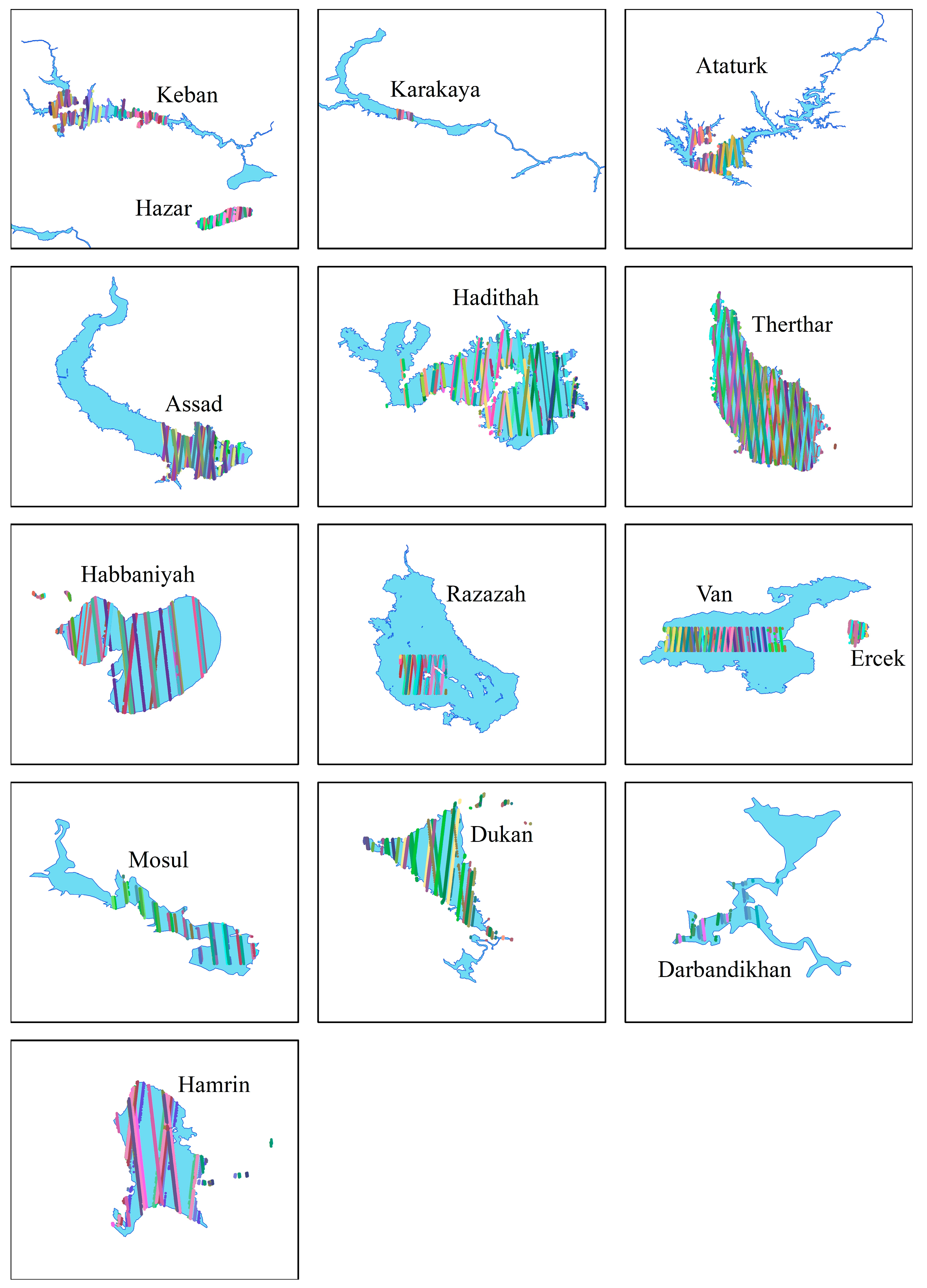
References
- World Economic, F. Global Risks 2015: Tenth Edition; World Economic Forum: Geneva, Switzerland, 2015. [Google Scholar]
- El-Fadel, M.; Sayegh, Y.E.; Ibrahim, A.A.; Jamali, D.; El-Fadl, K. The Euphrates–Tigris Basin: A Case Study in Surface Water Conflict Resolution. J. Nat. Resour. Life Sci. Educ. 2002, 31, 99–110. [Google Scholar] [CrossRef]
- Voss, K.A.; Famiglietti, J.S.; Lo, M.; de Linage, C.; Rodell, M.; Swenson, S.C. Groundwater depletion in the Middle East from GRACE with implications for transboundary water management in the Tigris-Euphrates-Western Iran region. Water Resour. Res. 2013, 49, 904–914. [Google Scholar] [CrossRef]
- Al-Taei, A.I.; Alesheikh, A.A.; Darvishi Boloorani, A. Land Use/Land Cover Change Analysis Using Multi-Temporal Remote Sensing Data: A Case Study of Tigris and Euphrates Rivers Basin. Land 2023, 12, 1101. [Google Scholar] [CrossRef]
- Kibaroglu, A.; Schmandt, J.; Ward, G. Engineered rivers in arid lands: Searching for sustainability in theory and practice. Water Int. 2017, 42, 241–253. [Google Scholar] [CrossRef]
- Food; Agriculture Organization of the United, N. Euphrates–Tigris River Basin. Available online: https://www.fao.org/aquastat/en/countries-and-basins/transboundary-river-basins/euphrates-tigris (accessed on 8 July 2025).
- Ozkaya, A.; Zerberg, Y. A 40-Year Analysis of the Hydrological Drought Index for the Tigris Basin, Turkey. Water 2019, 11, 657. [Google Scholar] [CrossRef]
- Daher, J. Water Scarcity, Mismanagement and Pollution in Syria; 929466323X; European University Institute: Fiesole, Italy, 2022. [Google Scholar]
- Kavvas, M.L.; Chen, Z.Q.; Anderson, M.L.; Ohara, N.; Yoon, J.Y.; Xiang, F. A study of water balances over the Tigris–Euphrates watershed. Phys. Chem. Earth Parts A/B/C 2011, 36, 197–203. [Google Scholar] [CrossRef]
- Bachmann, A.; Tice, V.; Al-Obeidi, L.A.; Kilıç, D.T. Tigris-Euphrates River ecosystem: A status report. In Mesopotamia Water Forum; Save The Tigris Foundation: The Hague, The Netherlands, 2019; pp. 6–8. Available online: https://www.savethetigris.org/wp-content/uploads/2019/03/Paper-Challenge-C-Ecosystem-FINAL-to-be-published-1.pdf (accessed on 8 July 2025).
- Crétaux, J.F.; Arsen, A.; Calmant, S.; Kouraev, A.; Vuglinski, V.; Bergé-Nguyen, M.; Gennero, M.C.; Nino, F.; Abarca Del Rio, R.; Cazenave, A.; et al. SOLS: A lake database to monitor in the Near Real Time water level and storage variations from remote sensing data. Adv. Space Res. 2011, 47, 1497–1507. [Google Scholar] [CrossRef]
- Schwatke, C.; Dettmering, D.; Bosch, W.; Seitz, F. DAHITI—An innovative approach for estimating water level time series over inland waters using multi-mission satellite altimetry. Hydrol. Earth Syst. Sci. 2015, 19, 4345–4364. [Google Scholar] [CrossRef]
- Phan, V.H.; Lindenbergh, R.; Menenti, M. ICESat derived elevation changes of Tibetan lakes between 2003 and 2009. Int. J. Appl. Earth Obs. Geoinf. 2012, 17, 12–22. [Google Scholar] [CrossRef]
- Lao, J.; Wang, C.; Nie, S.; Xi, X.; Wang, J. Monitoring and Analysis of Water Level Changes in Mekong River from ICESat-2 Spaceborne Laser Altimetry. Water 2022, 14, 1613. [Google Scholar] [CrossRef]
- Narin, O.G.; Abdikan, S. Multi-temporal analysis of inland water level change using ICESat-2 ATL-13 data in lakes and dams. Environ. Sci. Pollut. Res. 2023, 30, 15364–15376. [Google Scholar] [CrossRef]
- Ryan, J.C.; Smith, L.C.; Cooley, S.W.; Pitcher, L.H.; Pavelsky, T.M. Global Characterization of Inland Water Reservoirs Using ICESat-2 Altimetry and Climate Reanalysis. Geophys. Res. Lett. 2020, 47, e2020GL088543. [Google Scholar] [CrossRef]
- Han, W.; Huang, C.; Gu, J.; Hou, J.; Zhang, Y.; Wang, W. Water Level Change of Qinghai Lake from ICESat and ICESat-2 Laser Altimetry. Remote Sens. 2022, 14, 6212. [Google Scholar] [CrossRef]
- Du, Y.; Zhang, Y.; Ling, F.; Wang, Q.; Li, W.; Li, X. Water Bodies’ Mapping from Sentinel-2 Imagery with Modified Normalized Difference Water Index at 10-m Spatial Resolution Produced by Sharpening the SWIR Band. Remote Sens. 2016, 8, 354. [Google Scholar] [CrossRef]
- Kaplan, G.; Avdan, U. Object-based water body extraction model using Sentinel-2 satellite imagery. Eur. J. Remote Sens. 2017, 50, 137–143. [Google Scholar] [CrossRef]
- Sarp, G.; Ozcelik, M. Water body extraction and change detection using time series: A case study of Lake Burdur, Turkey. J. Taibah Univ. Sci. 2017, 11, 381–391. [Google Scholar] [CrossRef]
- Sekertekin, A.; Cicekli, S.Y.; Arslan, N. Index-Based Identification of Surface Water Resources Using Sentinel-2 Satellite Imagery. In Proceedings of the 2018 2nd International Symposium on Multidisciplinary Studies and Innovative Technologies (ISMSIT), Ankara, Turkey, 19–21 October 2018; pp. 1–5. [Google Scholar]
- Karaman, M. Comparison of thresholding methods for shoreline extraction from Sentinel-2 and Landsat-8 imagery: Extreme Lake Salda, track of Mars on Earth. J. Environ. Manag. 2021, 298, 113481. [Google Scholar] [CrossRef]
- Khalaf, A.B. Using remote sensing and geographic information systems to study the change detection in temperature and surface area of Hamrin Lake. Baghdad Sci. J. 2022, 19, 1130. [Google Scholar] [CrossRef]
- Gorelick, N.; Hancher, M.; Dixon, M.; Ilyushchenko, S.; Thau, D.; Moore, R. Google Earth Engine: Planetary-scale geospatial analysis for everyone. Remote Sens. Environ. 2017, 202, 18–27. [Google Scholar] [CrossRef]
- Chang, M.; Li, P.; Li, Z.; Wang, H. Mapping Tidal Flats of the Bohai and Yellow Seas Using Time Series Sentinel-2 Images and Google Earth Engine. Remote Sens. 2022, 14, 1789. [Google Scholar] [CrossRef]
- Chen, J.; Kang, T.; Yang, S.; Bu, J.; Cao, K.; Gao, Y. Open-Surface Water Bodies Dynamics Analysis in the Tarim River Basin (North-Western China), Based on Google Earth Engine Cloud Platform. Water 2020, 12, 2822. [Google Scholar] [CrossRef]
- Kandekar, V.U.; Pande, C.B.; Rajesh, J.; Atre, A.A.; Gorantiwar, S.D.; Kadam, S.A.; Gavit, B. Surface water dynamics analysis based on sentinel imagery and Google Earth Engine Platform: A case study of Jayakwadi dam. Sustain. Water Resour. Manag. 2021, 7, 44. [Google Scholar] [CrossRef]
- Jumaah, H.J.; Ameen, M.H.; Kalantar, B. Surface Water Changes and Water Depletion of Lake Hamrin, Eastern Iraq, Using Sentinel-2 Images and Geographic Information Systems. Adv. Environ. Eng. Res. 2023, 4, 006. [Google Scholar] [CrossRef]
- Torun, A.T.; Gündüz, H.İ. Comparison of Different Classification Algorithms for The Detection of Changes on Water Bodies; Karakaya Dam Lake. Turk. J. Geosci. 2020, 1, 27–34. [Google Scholar]
- Erdem, F.; Atun, R.; Yigit Avdan, Z.; Atila, I.; Avdan, U. Drought analysis of Van Lake Basin with remote sensing and GIS technologies. Egypt. J. Remote Sens. Space Sci. 2021, 24, 1093–1102. [Google Scholar] [CrossRef]
- Albarakat, R.; Lakshmi, V.; Tucker, C.J. Using Satellite Remote Sensing to Study the Impact of Climate and Anthropogenic Changes in the Mesopotamian Marshlands, Iraq. Remote Sens. 2018, 10, 1524. [Google Scholar] [CrossRef]
- Ökten, Ş.; Çeken, H. Gap Projesi’nin Türkiye’nin Kirsal Kalkinma Politikalari İçindeki Yeri ve Önemi. Tarım Ekon. Derg. 2008, 14, 13–22. [Google Scholar]
- Yavaşoğlu, H.H.; Kalkan, Y.; Tiryakioğlu, İ.; Yigit, C.O.; Özbey, V.; Alkan, M.N.; Bilgi, S.; Alkan, R.M. Monitoring the deformation and strain analysis on the Ataturk Dam, Turkey. Geomat. Nat. Hazards Risk 2018, 9, 94–107. [Google Scholar] [CrossRef]
- von Lossow, T. The Rebirth of Water as a Weapon: IS in Syria and Iraq. Int. Spect. 2016, 51, 82–99. [Google Scholar] [CrossRef]
- Neuenschwander, A.L.; Magruder, L.A. Canopy and Terrain Height Retrievals with ICESat-2: A First Look. Remote Sens. 2019, 11, 1721. [Google Scholar] [CrossRef]
- Neumann, T.; Brenner, A.; Hancock, D.; Robbins, J.; Saba, J.; Harbeck, K.; Gibbons, A.; Lee, J.; Luthcke, S.; Rebold, T. ATLAS/ICESat-2 L2A Global Geolocated Photon Data, Version 3; NASA National Snow and Ice Data Center Distributed Active Archive Center: Boulder, CO, USA, 2021. [Google Scholar]
- Jasinski, M.; Stoll, J.; Hancock, D.; Robbins, J.; Nattala, J.; Morison, J.; Jones, B.; Ondrusek, M.; Pavelsky, T.; Parrish, C.; et al. ATLAS/ICESat-2 L3A Inland Water Surface Height, Version 2; NASA National Snow and Ice Data Center Distributed Active Archive Center: Boulder, CO, USA, 2019. [Google Scholar] [CrossRef]
- Drusch, M.; Del Bello, U.; Carlier, S.; Colin, O.; Fernandez, V.; Gascon, F.; Hoersch, B.; Isola, C.; Laberinti, P.; Martimort, P.; et al. Sentinel-2: ESA’s Optical High-Resolution Mission for GMES Operational Services. Remote Sens. Environ. 2012, 120, 25–36. [Google Scholar] [CrossRef]
- Phiri, D.; Simwanda, M.; Salekin, S.; Nyirenda, V.R.; Murayama, Y.; Ranagalage, M. Sentinel-2 Data for Land Cover/Use Mapping: A Review. Remote Sens. 2020, 12, 2291. [Google Scholar] [CrossRef]
- Narin, O.G.; Abdikan, S. Monitoring of phenological stage and yield estimation of sunflower plant using Sentinel-2 satellite images. Geocarto Int. 2022, 37, 1378–1392. [Google Scholar] [CrossRef]
- Nasiri, V.; Deljouei, A.; Moradi, F.; Sadeghi, S.M.M.; Borz, S.A. Land Use and Land Cover Mapping Using Sentinel-2, Landsat-8 Satellite Images, and Google Earth Engine: A Comparison of Two Composition Methods. Remote Sens. 2022, 14, 1977. [Google Scholar] [CrossRef]
- Li, J.; Peng, B.; Wei, Y.; Ye, H. Accurate extraction of surface water in complex environment based on Google Earth Engine and Sentinel-2. PLoS ONE 2021, 16, e0253209. [Google Scholar] [CrossRef]
- Huntington, J.L.; Hegewisch, K.C.; Daudert, B.; Morton, C.G.; Abatzoglou, J.T.; McEvoy, D.J.; Erickson, T. Climate Engine: Cloud Computing and Visualization of Climate and Remote Sensing Data for Advanced Natural Resource Monitoring and Process Understanding. Bull. Am. Meteorol. Soc. 2017, 98, 2397–2410. [Google Scholar] [CrossRef]
- Muñoz-Sabater, J.; Dutra, E.; Agustí-Panareda, A.; Albergel, C.; Arduini, G.; Balsamo, G.; Boussetta, S.; Choulga, M.; Harrigan, S.; Hersbach, H.; et al. ERA5-Land: A state-of-the-art global reanalysis dataset for land applications. Earth Syst. Sci. Data 2021, 13, 4349–4383. [Google Scholar] [CrossRef]
- Jiang, Q.; Li, W.; Fan, Z.; He, X.; Sun, W.; Chen, S.; Wen, J.; Gao, J.; Wang, J. Evaluation of the ERA5 reanalysis precipitation dataset over Chinese Mainland. J. Hydrol. 2021, 595, 125660. [Google Scholar] [CrossRef]
- Duan, Z.; Bastiaanssen, W.G.M. Estimating water volume variations in lakes and reservoirs from four operational satellite altimetry databases and satellite imagery data. Remote Sens. Environ. 2013, 134, 403–416. [Google Scholar] [CrossRef]
- Muala, E.; Mohamed, Y.A.; Duan, Z.; Van der Zaag, P. Estimation of Reservoir Discharges from Lake Nasser and Roseires Reservoir in the Nile Basin Using Satellite Altimetry and Imagery Data. Remote Sens. 2014, 6, 7522–7545. [Google Scholar] [CrossRef]
- Khalsa, S.J.S.; Borsa, A.; Nandigam, V.; Phan, M.; Lin, K.; Crosby, C.; Fricker, H.; Baru, C.; Lopez, L. OpenAltimetry—Rapid analysis and visualization of Spaceborne altimeter data. Earth Sci. Inform. 2022, 15, 1471–1480. [Google Scholar] [CrossRef]
- Gautam, V.K.; Gaurav, P.K.; Murugan, P.; Annadurai, M. Assessment of Surface Water Dynamicsin Bangalore Using WRI, NDWI, MNDWI, Supervised Classification and K-T Transformation. Aquat. Procedia 2015, 4, 739–746. [Google Scholar] [CrossRef]
- Özelkan, E. Water Body Detection Analysis Using NDWI Indices Derived from Landsat-8 OLI. Pol. J. Environ. Stud. 2020, 29, 1759–1769. [Google Scholar] [CrossRef]
- McFeeters, S.K. The use of the Normalized Difference Water Index (NDWI) in the delineation of open water features. Int. J. Remote Sens. 1996, 17, 1425–1432. [Google Scholar] [CrossRef]
- Acharya, T.D.; Subedi, A.; Lee, D.H. Evaluation of Water Indices for Surface Water Extraction in a Landsat 8 Scene of Nepal. Sensors 2018, 18, 2580. [Google Scholar] [CrossRef]
- Acharya, T.D.; Subedi, A.; Yang, I.T.; Lee, D.H. Combining Water Indices for Water and Background Threshold in Landsat Image. Proceedings 2018, 2, 143. [Google Scholar]
- Al-Muqdadi, S.W.H. Developing Strategy for Water Conflict Management and Transformation at Euphrates–Tigris Basin. Water 2019, 11, 2037. [Google Scholar] [CrossRef]
- Liu, C.; Hu, R.; Wang, Y.; Lin, H.; Zeng, H.; Wu, D.; Liu, Z.; Dai, Y.; Song, X.; Shao, C. Monitoring water level and volume changes of lakes and reservoirs in the Yellow River Basin using ICESat-2 laser altimetry and Google Earth Engine. J. Hydro-Environ. Res. 2022, 44, 53–64. [Google Scholar] [CrossRef]
- Iwaki, M.; Yamashiki, Y.; Toda, T.; Jiao, C.; Kumagai, M. Estimation of the Average Retention Time of Precipitation at the Surface of a Catchment Area for Lake Biwa. Water 2021, 13, 1711. [Google Scholar] [CrossRef]
- Abdelmohsen, K.; Sultan, M.; Save, H.; Abotalib, A.Z.; Yan, E.; Zahran, K.H. Buffering the impacts of extreme climate variability in the highly engineered Tigris Euphrates river system. Sci. Rep. 2022, 12, 4178. [Google Scholar] [CrossRef]
- Darvishi Boloorani, A.; Soleimani, M.; Papi, R.; Nasiri, N.; Neysani Samany, N.; Mirzaei, S.; Al-Hemoud, A. Assessing the role of drought in dust storm formation in the Tigris and Euphrates basin. Sci. Total Environ. 2024, 921, 171193. [Google Scholar] [CrossRef] [PubMed]
- Chao, N.; Luo, Z.; Wang, Z.; Jin, T. Retrieving Groundwater Depletion and Drought in the Tigris-Euphrates Basin Between 2003 and 2015. Ground Water 2018, 56, 770–782. [Google Scholar] [CrossRef] [PubMed]
- van Gent, S.N.T. Water Surface Heights in the Upper Brahmaputra and Nam Co Basin with ICESat-2; Delft University of Technology: Delft, The Netherlands, 2021. [Google Scholar]
- Al-Obaidi, M.A.; Al-Timimi, Y.K. Change detection in mosul dam lake, north of iraq using remote sensing and gis techniques. Iraqi J. Agric. Sci. 2022, 53, 38–47. [Google Scholar] [CrossRef]
- Suwanprasit, C.; Srichai, N. Impacts of spatial resolution on land cover classification. Proc. Asia-Pac. Adv. Netw. 2012, 33, 39. [Google Scholar] [CrossRef]
- Mishra, V.N.; Prasad, R.; Kumar, P.; Gupta, D.K.; Dikshit, P.K.S.; Dwivedi, S.B.; Ohri, A. Evaluating the effects of spatial resolution on land use and land cover classification accuracy. In Proceedings of the 2015 International Conference on Microwave, Optical and Communication Engineering (ICMOCE), Odisha, India, 18–20 December 2015; pp. 208–211. [Google Scholar]
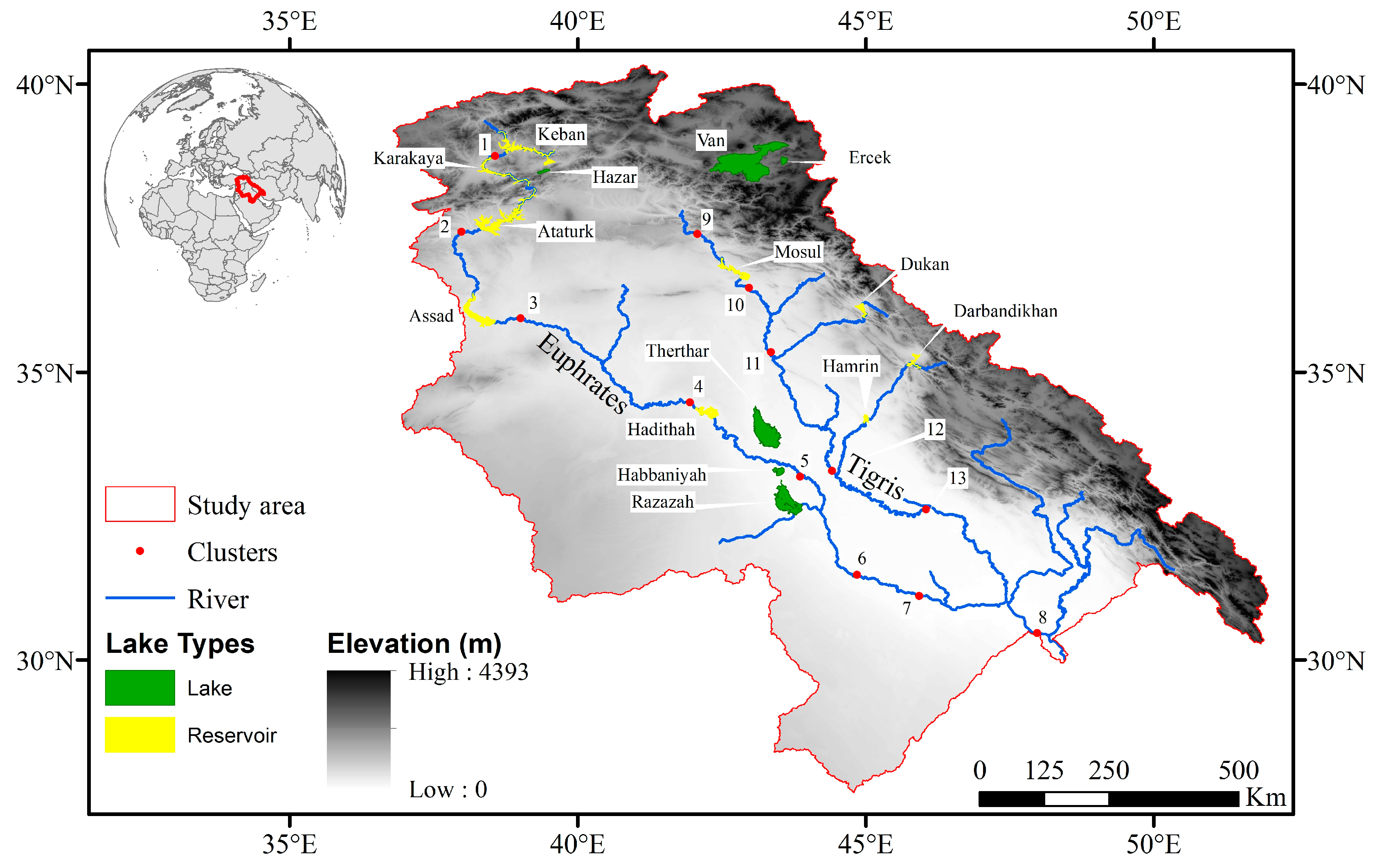
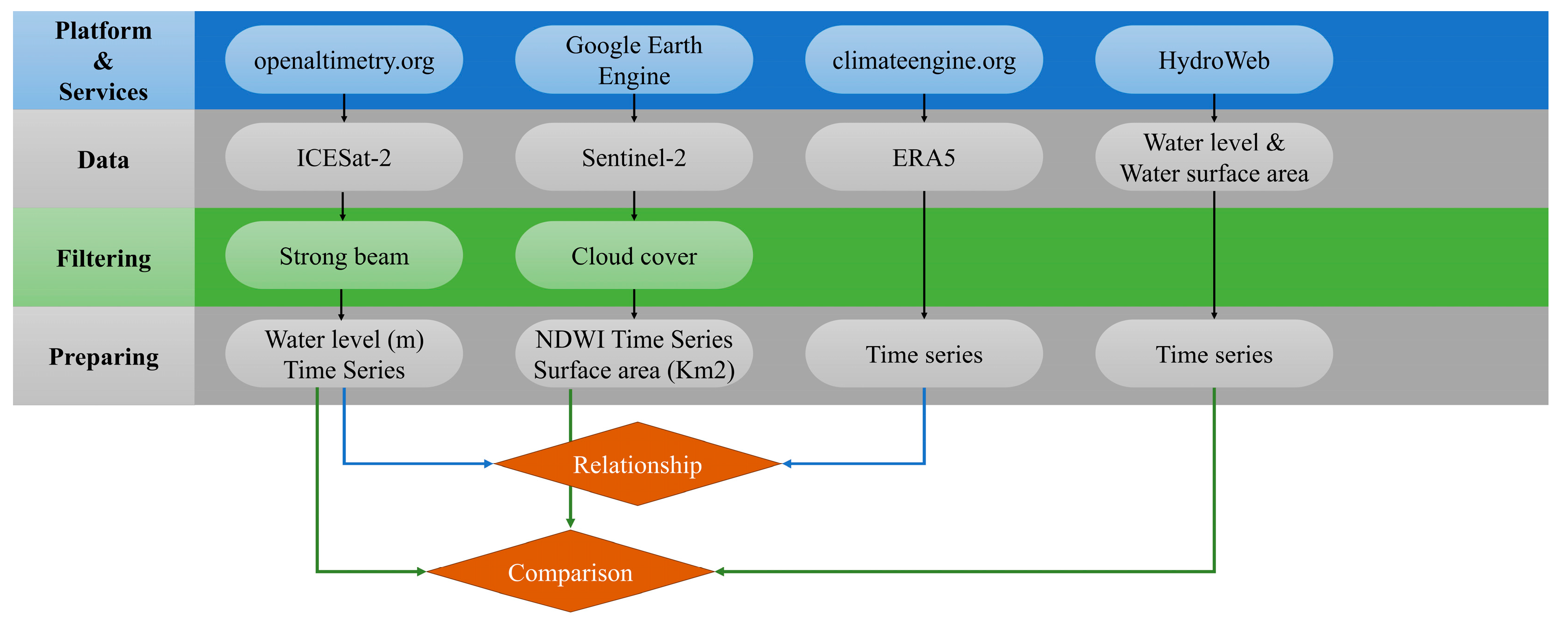

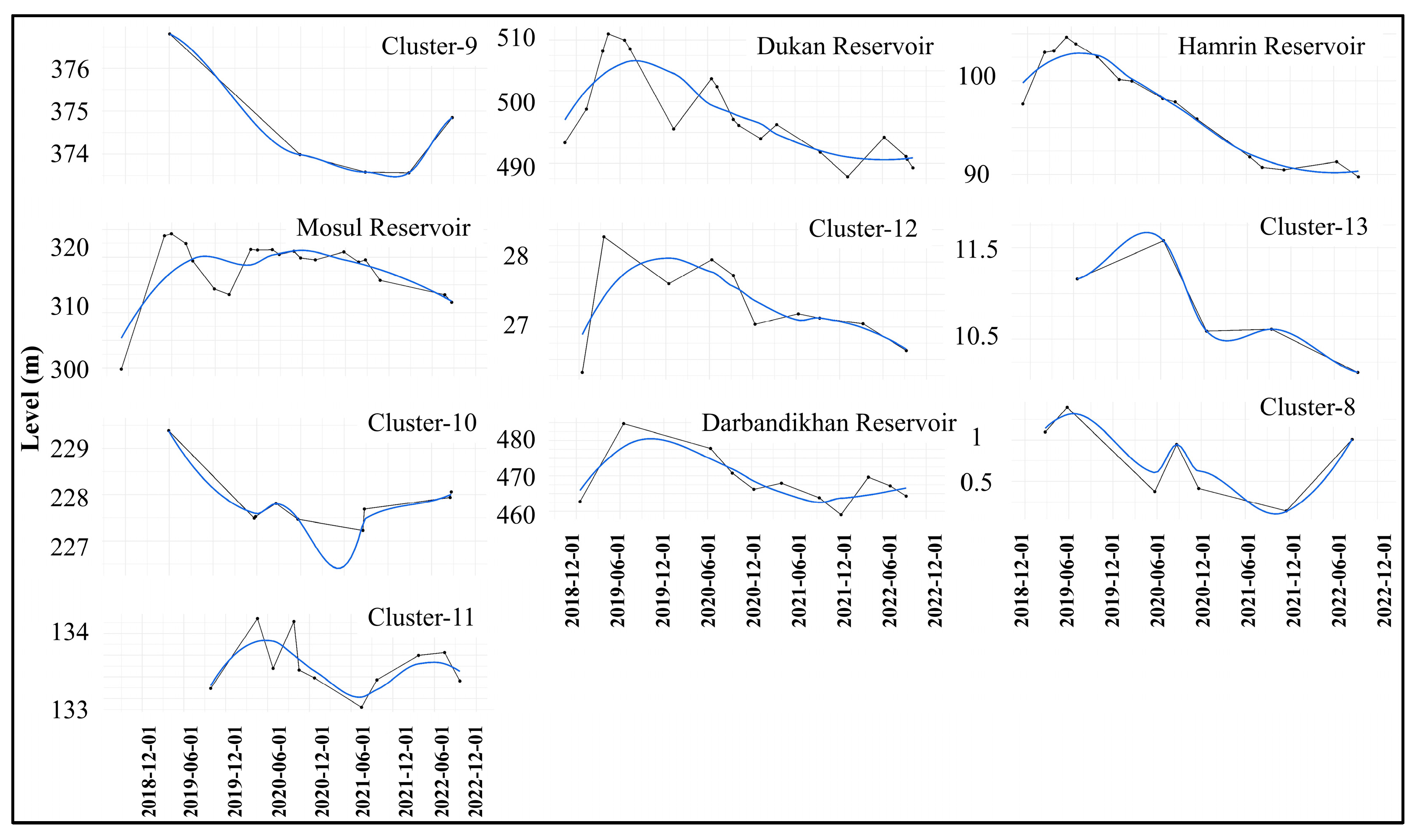


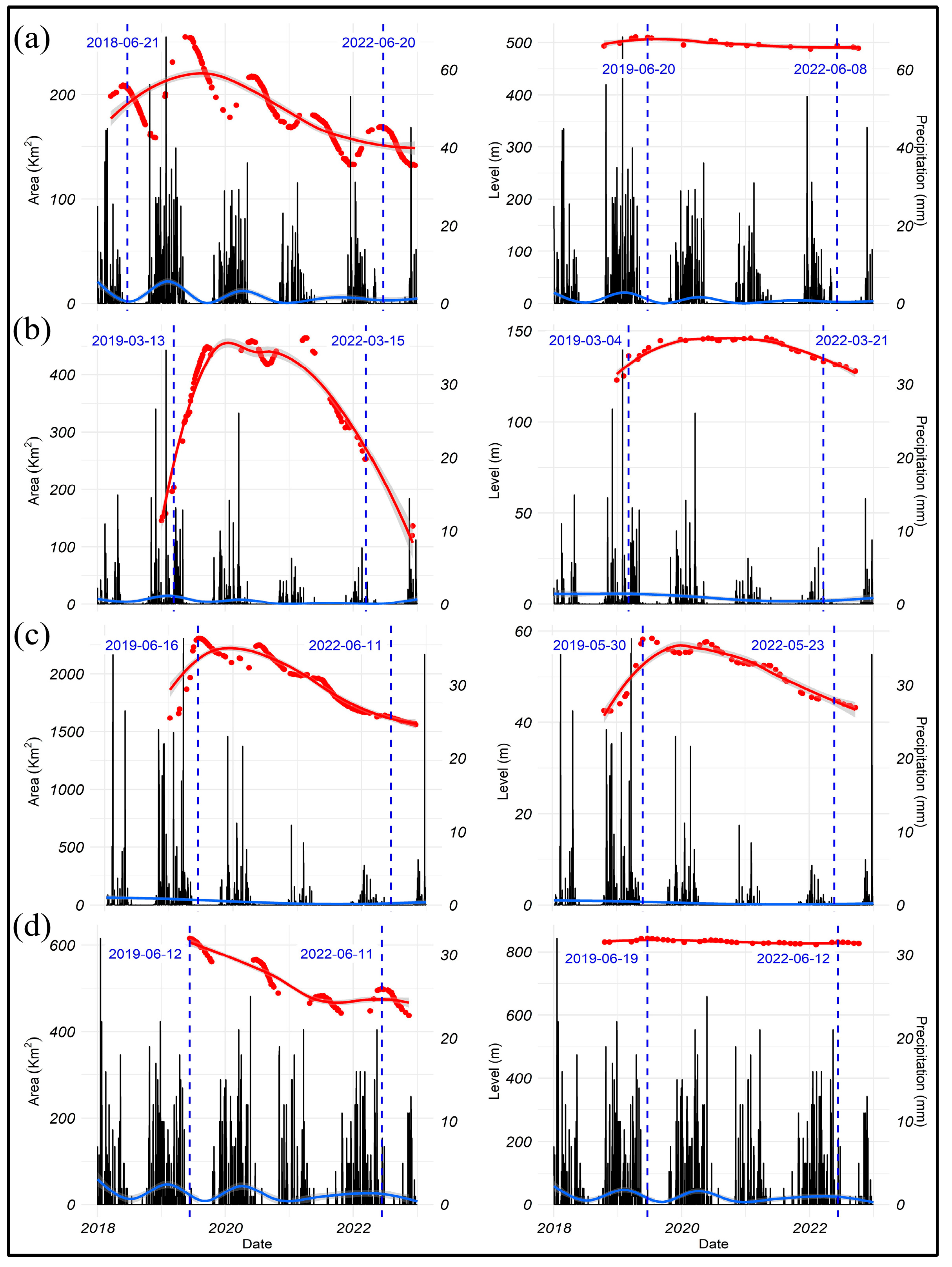

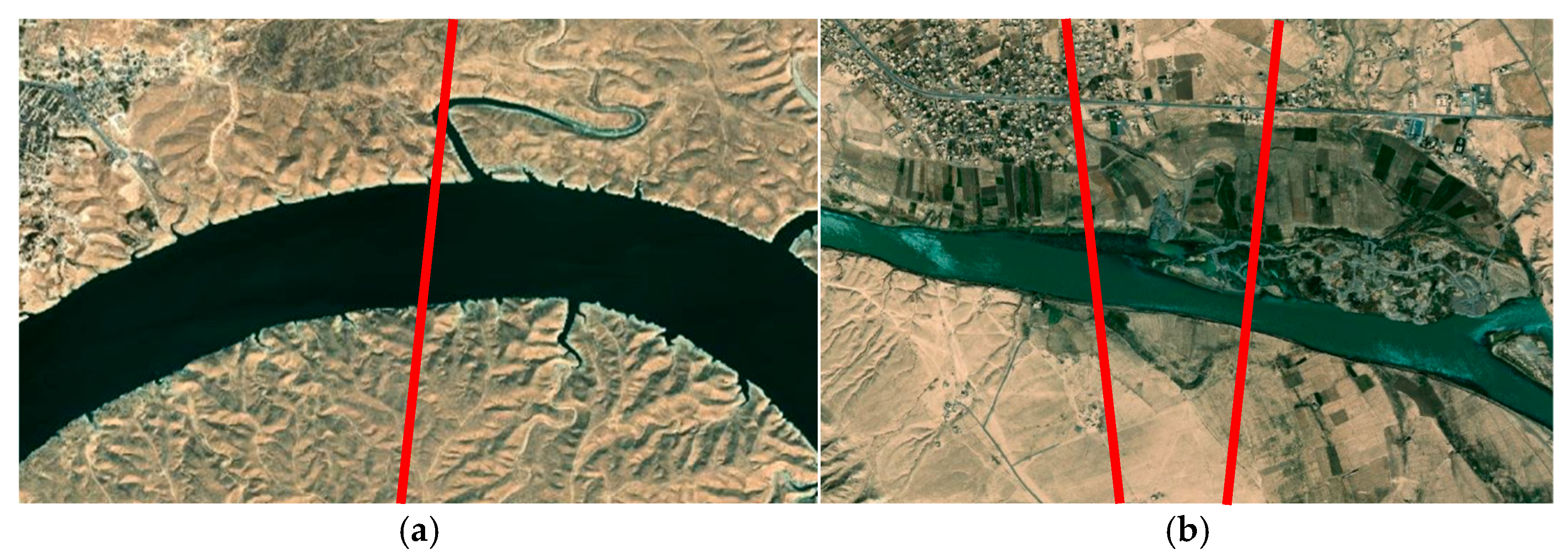
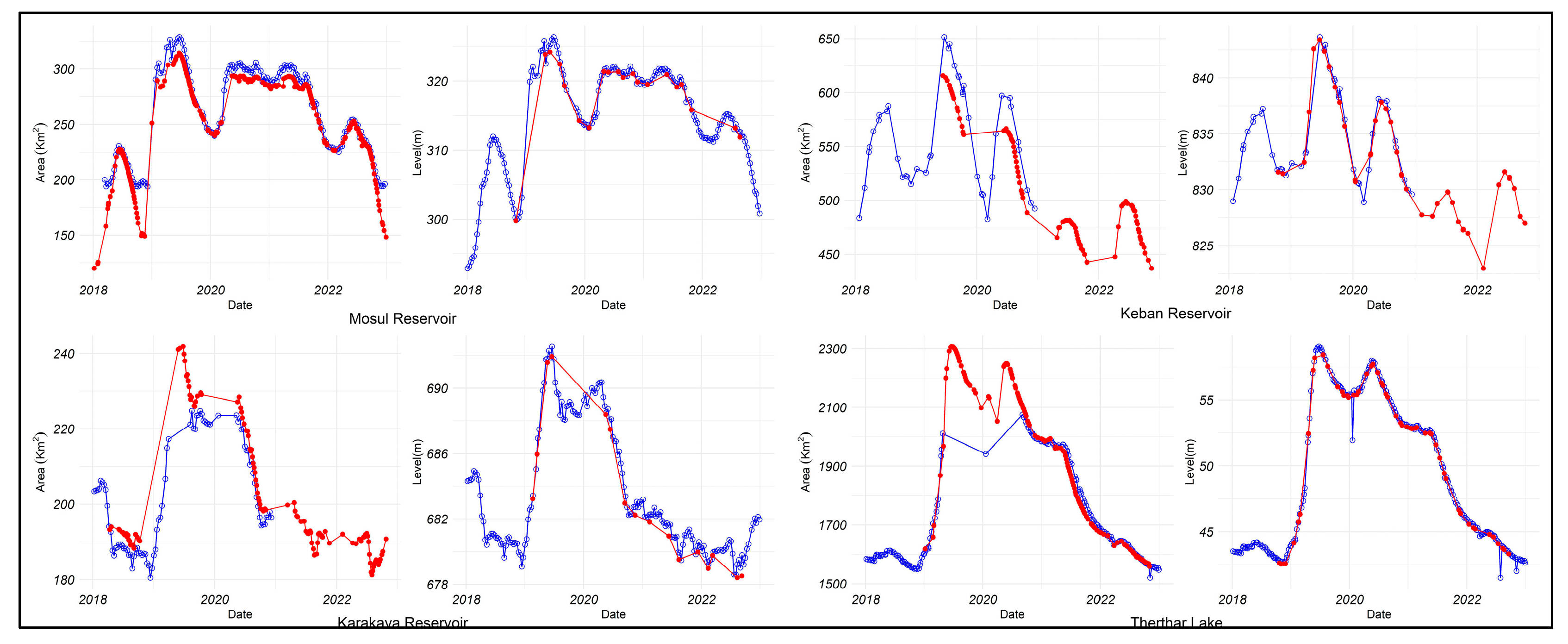
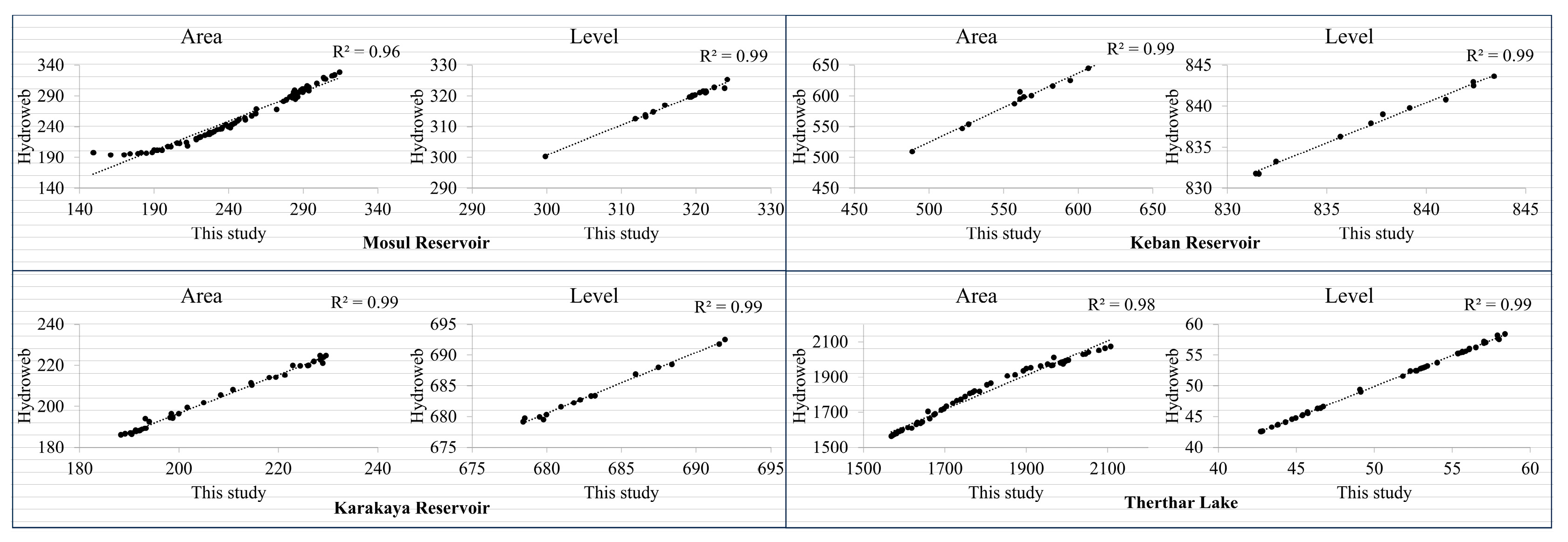
| Our Study | HydroWeb | Khalaf [23] Study | Differences | ||||
|---|---|---|---|---|---|---|---|
| Date | Level (m) | Date | Level (m) | Date | Level (m) * | Our | HydroWeb |
| 18 December 2019 | 100.131 | 10 December 2019 | 100 | 18 December 2019 | 100.403 | −0.27 | −0.40 |
| 9 February 2020 | 99.969 | 2 February 2020 | 99.88 | 4 February 2020 | 100.276 | −0.31 | −0.40 |
| 17 June 2020 | 98.101 | 16 June 2020 | 97.98 | 11 June 2020 | 98.398 | −0.30 | −0.42 |
| 8 August 2020 | 97.732 | 9 August 2020 | 97.61 | 14 August 2020 | 97.872 | −0.14 | −0.26 |
| Lake/Reservoir | First Date | Last Date | Nr. of Dates | Mean Area (km2) | Min. Area (km2) | Max. Area (km2) |
|---|---|---|---|---|---|---|
| Assad | 8 January 2018 | 28 December 2022 | 179 | 731.94 | 657.52 | 794.24 |
| Atatürk | 18 May 2018 | 3 November 2022 | 118 | 755.24 | 698.73 | 805.86 |
| Darbandikhan | 19 January 2019 | 29 December 2022 | 142 | 48.96 | 32.68 | 80.35 |
| Dukan | 18 March 2018 | 19 December 2022 | 259 | 181.80 | 131.97 | 255.11 |
| Ercek | 2 April 2018 | 30 December 2022 | 204 | 112.04 | 106.04 | 144.76 |
| Habbaniyah | 16 February 2019 | 2 December 2022 | 120 | 275.26 | 150.76 | 380.11 |
| Hadithah | 2 January 2019 | 5 December 2022 | 90 | 371.57 | 119.66 | 464.52 |
| Hamrin | 15 December 2018 | 29 December 2022 | 169 | 126.01 | 21.57 | 281.05 |
| Hazar | 7 February 2018 | 13 November 2022 | 129 | 79.00 | 78.09 | 79.52 |
| Karakaya | 13 April 2018 | 24 October 2022 | 120 | 201.29 | 181.23 | 241.87 |
| Keban | 12 June 2019 | 13 November 2022 | 95 | 511.76 | 425.93 | 615.72 |
| Mosul | 7 January 2018 | 30 December 2022 | 313 | 254.41 | 120.14 | 314.32 |
| Razazah | 28 December 2018 | 2 December 2022 | 142 | 379.03 | 158.26 | 616.56 |
| Therthar | 7 January 2019 | 2 November 2022 | 139 | 1939.74 | 1559.14 | 2307.26 |
| Van | 29 June 2018 | 13 July 2022 | 17 | 3571.19 | 3557.45 | 3579.05 |
| Our Study | Khalaf’s (2022) Study | Difference | ||
|---|---|---|---|---|
| Date | Area (km2) | Date | Area (km2) | |
| 10 November 2019 | 258.83 | 15 October 2019 | 264.617 | −5.784 |
| 20 November 2019 | 233.59 | 16 November 2019 | 232.595 | 0.992 |
| 20 December 2019 | 229.51 | 18 December 2019 | 226.802 | 2.707 |
| 4 January 2020 | 210.19 | 3 January 2020 | 206.558 | 3.627 |
| 3 February 2020 | 225.89 | 4 February 2020 | 212.774 | 13.118 |
| 23 May 2020 | 182.82 | 23 March 2020 | 200.519 | −17.699 |
| No data | No data | 8 April 2020 | 196.512 | No data |
| 13 May 2020 | 185.83 | 10 May 2020 | 174.833 | 10.994 |
| 12 June 2020 | 174.95 | 11 June 2020 | 159.535 | 15.415 |
| 12 July 2020 | 171.46 | 13 July 2020 | 154.562 | 16.901 |
| 16 August 2020 | 158.63 | 14 August 2020 | 152.186 | 6.443 |
| 20 September 2020 | 141.42 | 15 September 2020 | 140.202 | 1.222 |
Disclaimer/Publisher’s Note: The statements, opinions and data contained in all publications are solely those of the individual author(s) and contributor(s) and not of MDPI and/or the editor(s). MDPI and/or the editor(s) disclaim responsibility for any injury to people or property resulting from any ideas, methods, instructions or products referred to in the content. |
© 2025 by the authors. Licensee MDPI, Basel, Switzerland. This article is an open access article distributed under the terms and conditions of the Creative Commons Attribution (CC BY) license (https://creativecommons.org/licenses/by/4.0/).
Share and Cite
Narin, O.G.; Lindenbergh, R.; Abdikan, S. Temporal Analysis of Reservoirs, Lakes, and Rivers in the Euphrates–Tigris Basin from Multi-Sensor Data Between 2018 and 2022. Remote Sens. 2025, 17, 2913. https://doi.org/10.3390/rs17162913
Narin OG, Lindenbergh R, Abdikan S. Temporal Analysis of Reservoirs, Lakes, and Rivers in the Euphrates–Tigris Basin from Multi-Sensor Data Between 2018 and 2022. Remote Sensing. 2025; 17(16):2913. https://doi.org/10.3390/rs17162913
Chicago/Turabian StyleNarin, Omer Gokberk, Roderik Lindenbergh, and Saygin Abdikan. 2025. "Temporal Analysis of Reservoirs, Lakes, and Rivers in the Euphrates–Tigris Basin from Multi-Sensor Data Between 2018 and 2022" Remote Sensing 17, no. 16: 2913. https://doi.org/10.3390/rs17162913
APA StyleNarin, O. G., Lindenbergh, R., & Abdikan, S. (2025). Temporal Analysis of Reservoirs, Lakes, and Rivers in the Euphrates–Tigris Basin from Multi-Sensor Data Between 2018 and 2022. Remote Sensing, 17(16), 2913. https://doi.org/10.3390/rs17162913








